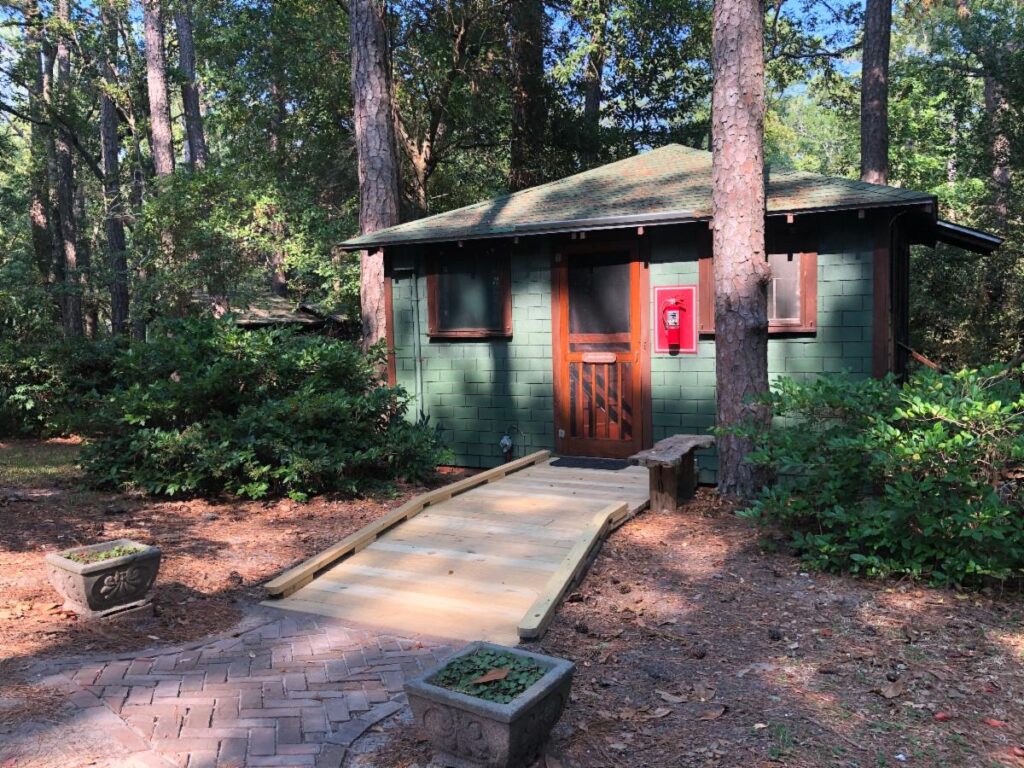
September 30, 2019
Creating Access
I was in the Original Kitchen a few days ago when a young woman entered in a wheelchair. She was glowing. She had been to the Center numerous times over the years, but had never before been able to enter the Lagoon Cabin due to her disability. She told me
that that morning, she was able to go inside for the first time.
During the last few years, there have been more and more conversations about how to make sure that Baba’s lovers with different physical needs are able to spend time in His sacred spaces on the Center. One of our community members who is herself in a wheelchair, and has contributed a lot of time and love as a member of the Center’s Accessibility Committee, put it beautifully:
“Overall, I’ve thought so much about this. In His later years, Baba could not have gone to His own Barn the way it is now if He were not in a lift-chair. Through His suffering, He has given the example for how we should treat those with disabilities … We are getting older. He wanted us to be practical and inclusive. It is especially important for those who are injured, ill or disabled to be able to commune and feel Baba’s healing places.”
This doesn’t mean that the process will be easy. There is an inevitable tension between making changes that feel loving and pleasing to Baba, and retaining the integrity of these sacred buildings that Baba used and that are so important to all of us. It can be hard to see any changes to the buildings, and of course builders, architects, and staff working on the projects are deeply sensitive to that.
For example, a leader of the team working on the Lagoon Cabin ramp describes some of the considerations that went into the project. The ramp is made out of pine, which, when weathered and treated, will blend in visually and not detract from the overall appearance of the building. It doesn’t actually touch the wall of the Cabin itself, to preserve the building’s historical integrity. And it takes a meandering path, in the style of the brick walkway that had been there since the 80’s, the end of which was left in place as an approach. Even the bench, which has been used by devotees for decades to take off their shoes before greeting their Beloved, was raised and preserved.
Baba’s lovers were working together for access when He was still in the body. After Baba’s accident in 1957, when His hip joint was shattered, causing Him constant pain and making it difficult to walk, Elizabeth created the second door to the Lagoon Cabin where the ramp is now. During His 1958 visit, Baba went from place to place using a Lift Chair, which gave four lucky people at a time the chance to carry Him (a highly in-demand role often vied for by Margaret Craske’s dancers). And now, going forward, the Center’s board and administration is committed to continuing this balancing work, between creating access and caring for these precious places—Baba’s House, the Original Kitchen, the Lagoon Cabin, and, next, the Barn.
Baba’s House, which is where this process started, is perhaps where the work and the balance strike me most vividly. Before the alteration, the member of the Accessibility Committee quoted above describes the process of getting into Baba’s house as nerve-wracking at times because of the steep grade of the temporary ramps, and requiring multiple people to help. For people with certain disabilities, or without the right helpers, it would be simply impossible.
A change was needed if many of Baba’s lovers were to be able to spend time in the home He left for them, today and in the future. But that change was completed with the incredible devotion and care that we have come to expect from our workers: for example, the original steps are in fact still there under the brick, painstakingly coated in rubber sheeting. “We didn’t just throw a bunch of cement and bricks on top of the old steps that Baba used,” says a leader of the team. “They’re there. But covered.”
It’s somehow striking that once this dynamic labor of love was complete, the first person to use the ramp was Tex Hightower. Decades before, Tex was one of the dancers who had jostled with the other young men to have a chance to carry his Beloved on the lift-chair, so that Baba Himself could enter every building of His home.